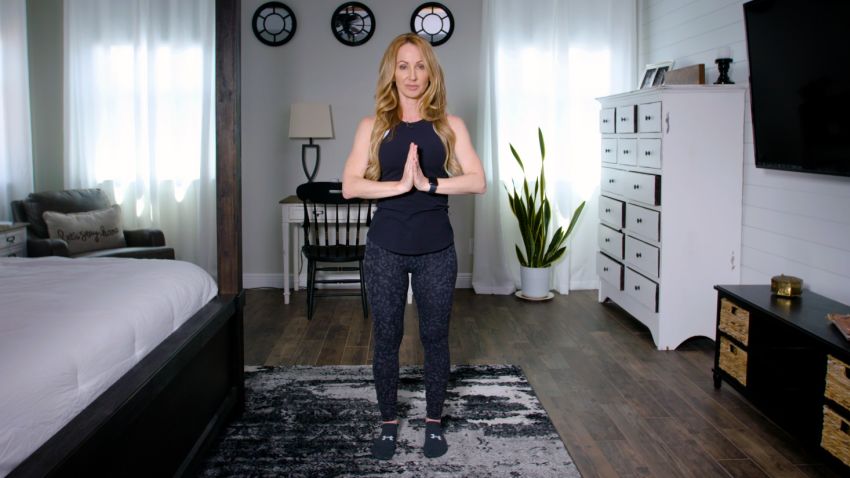Editor’s note: Dana Santas, known as the “Mobility Maker,” is a certified strength and conditioning specialist and mind-body coach in professional sports, and is the author of the book “Practical Solutions for Back Pain Relief.”
If you’re feeling as if you’re spinning your wheels at the gym, welcome to the club. At some point in most people’s fitness journeys, they hit a plateau — progress stalls and motivation wanes. But fear not. Breaking out of this rut is achievable with the right approach.
When you reach a point at which you’re training consistently but not seeing results, pushing harder is rarely the answer. In fact, the key to progress in your workouts is more likely doing less — not more.
Many people inadvertently overtrain because they don’t realize that the transformative magic actually happens during recovery. When you exercise, you push your body to the point of cellular breakdown with the intention of building it back up to be stronger and more efficient, which can only happen with adequate recovery time.
Below, I’ve outlined how to get the recovery time you need and four more strategies to help you jump-start your progress and reignite your passion for working out.
Prioritize recovery
Overtraining is a surefire recipe for hindered progress because you are continually breaking down muscle and creating inflammation without allowing time to recover and rebuild — making exercise counterproductive. This phenomenon is called overtraining syndrome, or OTS, which negatively affects your fitness and can lead to injuries.

Although consistent, quality sleep is a fundamental element of recovery, it isn’t the only factor. Prioritize recovery during your workouts by resting in between sets, staying hydrated and cooling down when you’re finished.
In between more strenuous workouts, incorporate days off and active recovery sessions that include yoga or even gentle stretching on your couch. Also consider additional soft-tissue recovery modalities such as foam rolling and massage. Finally, give your body the fuel it needs to rebuild with a balanced, nutritious diet.
Mix up your routine
One of the most common reasons for hitting a plateau is sticking with the same workout for too long. Your body naturally adapts to repetitive movements, leading to diminished returns. That’s why cross-training is crucial to overall fitness success. Cross-training involves diversifying your workouts to incorporate a variety of activities and exercises targeting different muscle groups and movement patterns. This doesn’t mean that you need to add more to what you’re already doing, rather that you need to change some of it.
Whether it’s swapping out your usual run for a bike ride or swim, or adding Pilates to your weekly schedule, cross-training helps keep your workouts fresh and interesting. And by challenging your muscles in new, creative ways, cross-training not only breaks the monotony but also stimulates growth and development. It’s like giving your body a wake-up call, prompting it to adapt and progress beyond its current limitations.
Set SMART goals
Ineffective goal setting is another pitfall that can land you in a rut. Vague goals lead to frustration and demotivation. Using the SMART goal-setting framework, you can set meaningful, actionable goals. Originally coined by George T. Doran in 1981, the SMART acronym has had various definitions over the decades to fit the context of use. For our purposes, we’ll use the widely recognized variation of specific, measurable, achievable, relevant and time-bound.
Putting it all together, here’s how you could transform a well-intentioned but vague goal, such as “I want to be healthier so I can be a better parent,” into a SMART goal:
Specific: I aim to increase my strength and cardiovascular endurance so I can better care for and play with my daughter.
Measurable: I will be able to confidently carry my 3-year-old daughter and actively play with her on the playground without feeling fatigued.
Achievable: I will achieve my goal by waking up one hour earlier to follow a workout program that includes strength training three times per week and cardiovascular exercise two times per week.
Relevant: This goal aligns with my desire to be an active and engaged parent, fostering a healthy lifestyle for both myself and my daughter.
Time-bound: I will achieve this goal within six months by following a structured workout routine and monitoring my progress regularly.
Track progress — big and small
When you’ve been maintaining a regular exercise routine for some time, it can be easy to lose sight of how far you’ve come. Without lofty fitness goals to chase, you might be feeling demotivated. Don’t mistake your disciplined commitment to sustained health for a lack of progress or reaching a plateau. To maintain your health, you are regularly hitting impressive milestones that you likely aren’t realizing.
By monitoring your workouts using a fitness journal, smartphone app or wearable device, you can start recognizing indicators of your success. Tracking a variety of measurable criteria, such as weights lifted, distances you walked/ran, and heart-rate levels, will enable you to focus on the smaller yet significant markers that make progress more tangible.
Celebrate your achievements, no matter how modest they might seem, as they signify forward momentum in your commitment to your own well-being.
Seek professional guidance
The strategies above can be employed without the help of a trainer, but don’t hesitate to seek the support of a fitness professional. A certified personal trainer or strength and conditioning coach can provide expert advice, personalized guidance and customized workout plans to help you break through your plateau to make safe and effective progress toward your fitness goals.
Hiring a trainer or coach is not only an investment of your time and money but also requires a level of trust, so it’s important to practice due diligence to find a reputable personal trainer who is a good fit for your needs.
Remember, hitting a fitness plateau rarely means you aren’t doing enough; it’s a natural part of the journey. Leveraging the strategies above, you can break free from stagnation, reignite your passion for fitness and get back on the road to your fitness goals.
Sign up for CNN’s Fitness, But Better newsletter series. Our seven-part guide will help you ease into a healthy routine, backed by experts.






